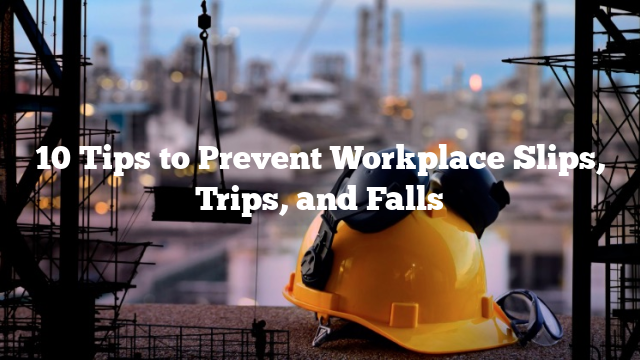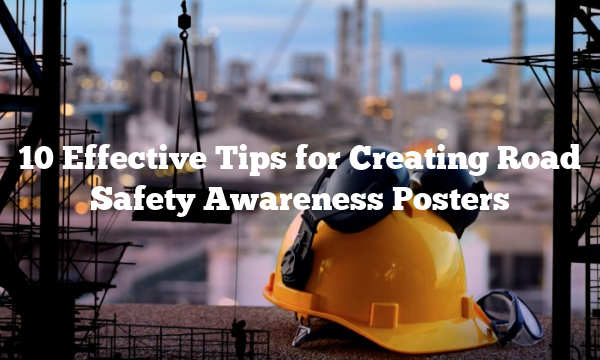Introduction:
Slips, trips, and falls are among the most common workplace accidents. They can happen anywhere, anytime, and to anyone. These accidents can cause serious injuries, and in some cases, even death. It is essential to take steps to prevent these accidents from happening in the workplace. In this article, we will explore workplace slips trips and falls prevention, and provide tips to ensure a safe working environment for everyone.
What is Workplace Slips Trips and Falls Prevention?
Workplace slips trips and falls prevention refers to the steps taken to reduce the risk of accidents in the workplace. It involves identifying potential hazards and taking appropriate measures to eliminate or control them. The goal of workplace slips trips and falls prevention is to create a safe working environment for employees, reduce the number of accidents, and minimize the risk of injuries and fatalities.
Why is Workplace Slips Trips and Falls Prevention Important?
Workplace slips trips and falls prevention is essential for several reasons. First, it ensures the safety of employees, which is crucial for their wellbeing and productivity. Second, it reduces the risk of lawsuits and compensation claims, which can be costly for employers. Finally, it promotes a positive safety culture, where employees feel valued and cared for.
Facts about Workplace Slips Trips and Falls Prevention:
– Slips, trips, and falls are responsible for 15% of all accidental deaths in the workplace.
– The construction industry has the highest number of workplace slips trips and falls accidents.
– The most common causes of slips, trips, and falls are wet and slippery floors, uneven surfaces, and inadequate lighting.
– Workplace slips trips and falls prevention can save businesses up to $70 billion annually.
Tutorial of Workplace Slips Trips and Falls Prevention:
1. Identify Potential Hazards: The first step in workplace slips trips and falls prevention is to identify potential hazards in the workplace. This can be done through regular inspections, risk assessments, and employee feedback.
2. Implement Control Measures: Once potential hazards have been identified, appropriate control measures should be implemented to eliminate or reduce the risk of accidents. This can include installing non-slip flooring, improving lighting, and providing appropriate footwear.
3. Train Employees: All employees should receive training on workplace slips trips and falls prevention. This should include information on how to identify hazards, how to report accidents, and how to use equipment safely.
Tips of Workplace Slips Trips and Falls Prevention:
1. Keep Walkways Clear: Keep walkways clear of clutter, obstacles, and debris. This can reduce the risk of trips and falls.
2. Use Warning Signs: Use warning signs to alert employees of potential hazards, such as wet floors or uneven surfaces.
3. Wear Appropriate Footwear: Encourage employees to wear appropriate footwear with slip-resistant soles to reduce the risk of slips and falls.
4. Provide Adequate Lighting: Ensure that all areas of the workplace are adequately lit to reduce the risk of accidents.
Question and Answer of Workplace Slips Trips and Falls Prevention:
1. What are the most common causes of workplace slips trips and falls accidents?
The most common causes of workplace slips trips and falls accidents are wet and slippery floors, uneven surfaces, and inadequate lighting.
2. How can workplace slips trips and falls prevention save businesses money?
Workplace slips trips and falls prevention can save businesses up to $70 billion annually by reducing the number of accidents, compensation claims, and legal fees.
3. Who is responsible for workplace slips trips and falls prevention?
Employers are responsible for workplace slips trips and falls prevention. They must identify potential hazards, implement control measures, and provide employees with appropriate training.
4. How can employees contribute to workplace slips trips and falls prevention?
Employees can contribute to workplace slips trips and falls prevention by reporting potential hazards, following safety procedures, and wearing appropriate footwear.
Conclusion of Workplace Slips Trips and Falls Prevention:
Workplace slips trips and falls prevention is crucial for creating a safe working environment for employees. By identifying potential hazards, implementing control measures, and providing appropriate training, employers can reduce the risk of accidents and promote a positive safety culture. Employees should also play an active role in workplace slips trips and falls prevention by following safety procedures and reporting potential hazards. By working together, we can create a safer workplace for everyone.
Recommendations:
- The Importance of Wearing Safety Goggles in the Workplace Safety Goggles Uses: How to Protect Your Eyes from Potential Hazards We use our eyes to perceive the world around us, to communicate, and to work. However, our eyes are…
- Workplace Safety Inspection Checklist Includes checks for fire prevention general safety vehicles. Date item condition follow up needed. Pshsa Sample Workplace Inspection Checklist The best checklist for your workplace is one that has been…
- Food Safety Quotes Funny The fda mostly handles everything. As described in our earlier post on safety slogans safety posters can be installed throughout the organization to educate employees to work safely. 42 Catchy…
- Environment Health Safety Logo Downloading this artwork you agree to the following. Download health and safety stock photos. Hse Health Safety And Environment Intecsa Industrial Affordable and search from millions of royalty free images…
- Free Health And Safety Images If you're searching for free health and safety images images information linked to the free health and safety images keyword, you have pay a visit to the ideal site. Our…
- Occupational Health And Safety Logo Information and documents a z. Occupational health and safety png images. Occupational Health Safety Logo Free Transparent Png Download Health and safety sign board hair. Occupational health and safety logo.…
- 7 Tips for Preventing Slips, Trips, and Falls in the… Introduction: Slips, trips, and falls are some of the most common workplace accidents, causing not only physical harm but also financial losses for businesses. According to the Occupational Safety and…
- Creating an Effective Road Safety Chart: Tips and Techniques Road Safety Chart Drawing: A Complete Guide to Creating and Maintaining Safe Roads Introduction: Road safety is a major concern for everyone, whether you are a driver, pedestrian, or cyclist.…
- Understanding the Importance of Safety Health and… Introduction: Safety, health, and environment (SHE) are three critical aspects that no business or organization can afford to ignore. As global awareness about these issues continues to increase, more and…
- Safety Hazard Meaning 2013 defines hazard a subjective concept that refers to the possibility of the circumstances under which the matter field information energy or both of them may influence the complex system…
- Workplace Health And Safety Representative Poster Health and safety representatives information for elected health and safety representatives hsrs. But reminders posted in your workplace andor community can help. Effective Health And Safety Committees Infographic One of…
- 7 Tips for Preventing Workplace Slips, Trips, and Falls Workplace Slips Trips and Falls Prevention As an employee or an employer, have you ever thought about the importance of preventing slips, trips, and falls in the workplace? Workplace slips,…
- Get PPE Easily with a PPE Vending Machine PPE Vending Machine. Personal Protective Equipment (PPE) is an essential component for the safety of many individuals. It provides the necessary protection to ensure that employees and individuals are safe…
- Health And Safety Inspection Procedure Further information of the inspection procedure is available. First aid in the workplace. Ohs Worksite Inspections February Health Safety Systems The Goal Health and safety committees can help plan conduct…
- The Top 10 Safety Hazard In Kitchen and How To… Each group is allocated one of the food safety hazard in kitchen and must come up with a short drama that shows. We use our kitchens every day to prepare…
- 10 Creative Ideas for Lab Safety Posters Introduction: When it comes to working in a laboratory, safety should always be a top priority. From handling dangerous chemicals to operating complex equipment, there are numerous hazards that lab…
- Health And Safety Topics Occupational health safety is the industry leading news magazine enewsletter and website for occupational health and safety professionals focusing on problem solving solutions latest news. Health safety committee member health…
- Workplace Health And Safety Logo The orange color also is representative of the cautious and careful attitude necessary to. Find health and safety logo stock images in hd and millions of other royalty free stock…
- Health And Safety Site Inspection Template Where a health and safety representative has drawn your attention to the findings of an inspection they have. Health and safety annual audit action plan. Form 007 Hse Weekly Inspection…
- How to Prevent Workplace Slips, Trips, and Falls: A… Workplace Slips, Trips, and Falls Prevention: How to Keep Your Employees Safe Slips, trips, and falls are some of the most common accidents that happen in workplaces. According to the…
- Safety Quotes Pictures A group of wonderfully cared for confident individuals will generate great ideas. You are looking for the safety quotes which helps us to free from harm or danger. Safety Doesn…
- Safety Topics For Fall Replace smoke alarm alkaline batteries at least once a year. Free safety topics toolbox talks safety meetings tailgate topics and safety resources including presentations photographs and documents. Fall Safety Tips…
- 5 Tips for Preventing Workplace Slips, Trips, and Falls Workplace Slips Trips and Falls Prevention Every year, millions of people suffer from injuries caused by slips, trips, and falls in the workplace. These accidents can happen in any industry,…
- 10 Effective Measures to Prevent Workplace Slips,… Workplace Slips Trips and Falls Prevention: Keeping Your Workplace Safe Workplace safety is an essential aspect of any business operation. Many accidents can occur in the workplace, but slips, trips,…
- 5 Essential Tips for Preventing Workplace Slips,… Introduction Slips, trips, and falls are the leading causes of workplace accidents and injuries. Whether you work in an office or a factory, the risk of slipping, tripping, and falling…
- The Importance of Job Safety Analysis for Loading… Job Safety Analysis for Loading and Unloading: Keeping Workers Safe As businesses continue to grow, loading and unloading activities have become more common. While these activities are necessary for the…
- Workplace Safety Signs And Symbols, Why so important? Proper workplace safety signs and symbols always place in a construction site, mining site, oil and gas site or hospital and your workplace.
- The Importance of Embracing Discomfort for Ultimate Safety No Safety, Know Pain; Know Safety, No Pain Essay: Why Safety Should Be a Priority in Our Lives Safety is one of the most essential aspects of life, yet it…
- Safety Precautions Meaning Safety precautions meaning are measures taken to prevent or reduce the risk of accidents, injuries, illnesses, or damages in various settings and situations. Safety precautions are essential for protecting workers,…
- Hazard And Risk Images If you're searching for hazard and risk images images information linked to the hazard and risk images keyword, you have come to the ideal site. Our site frequently gives you…
Advertisement
Scroll to Continue With Content




